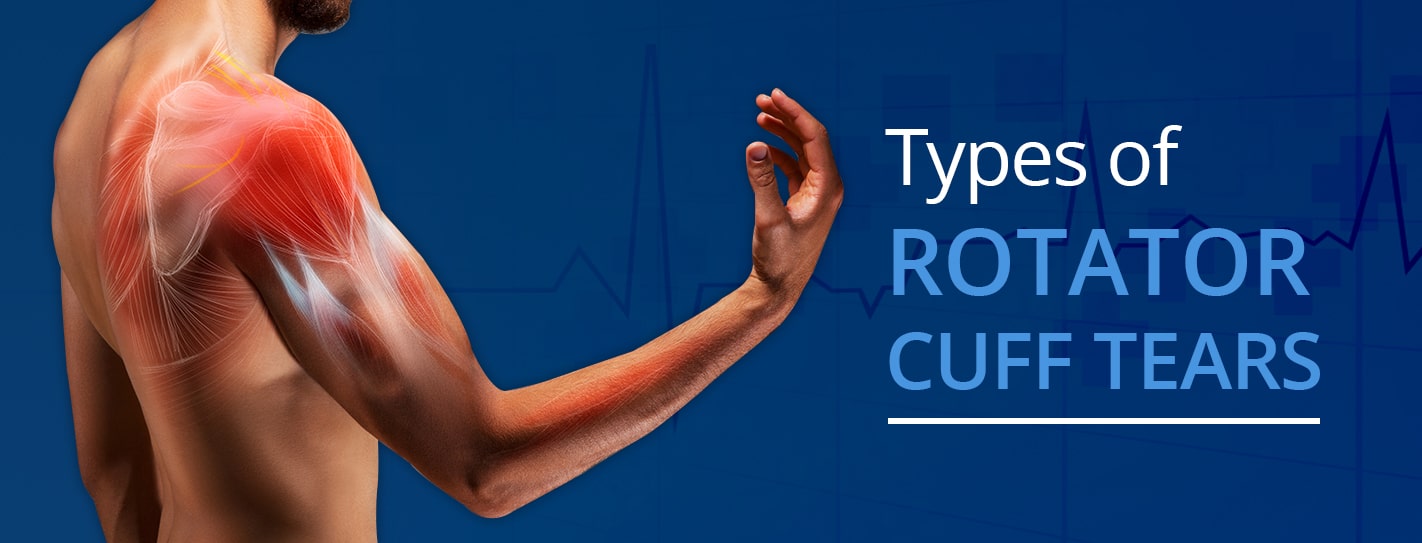
If you’ve had any kind of shoulder discomfort, chances are you’ve heard about rotator cuff injuries and the pain and complications they can bring on. Your shoulder joint is an extremely complex body part that allows your arm to have its remarkable range of motion. However, this complexity can also cause it to be susceptible to injury like a rotator cuff tear, and when there is an injury, this important joint’s lack of mobility can be particularly uncomfortable and frustrating.
Every year, around 2 million individuals in the U.S. see their physicians due to rotator cuff issues.
If you’re suffering from a tear in your rotator cuff, you may be asking yourself, “Are there different types of rotator cuff tears?” The answer is yes, and below you’ll learn more about the different rotator cuff tears as well as other essential information such as the different types of rotator cuff injuries, symptoms and how your surgeon repairs them.
What Is a Rotator Cuff Tear?
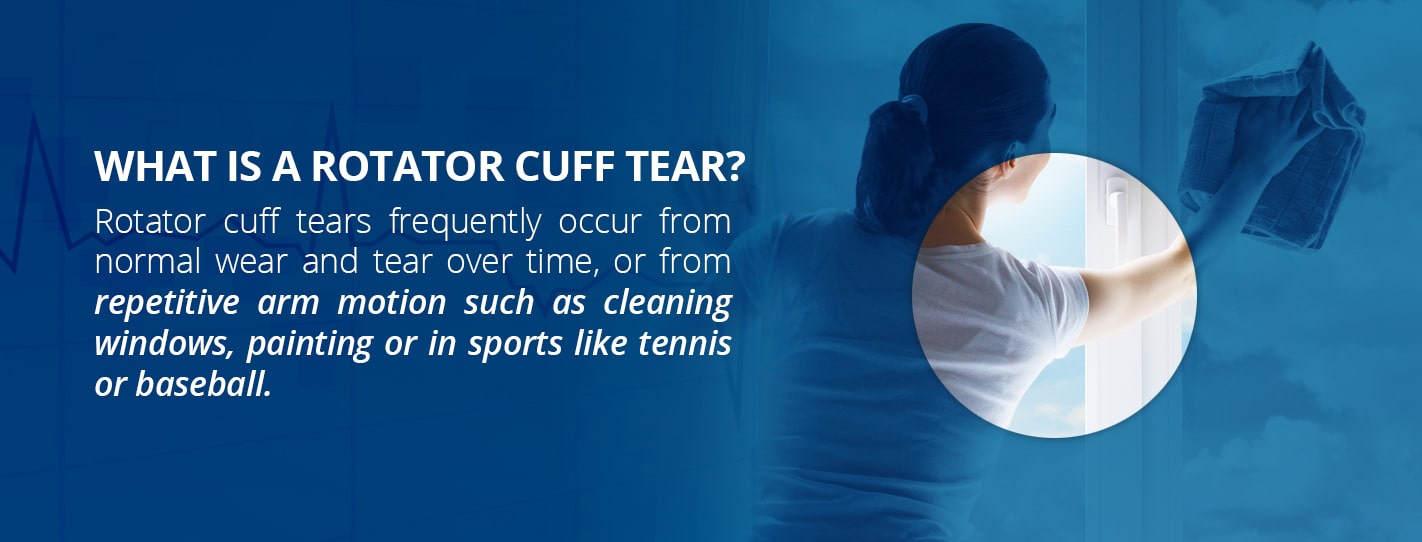
Rotator cuff tear conditions are common, particularly in jobs like cleaning windows or painting or in sports like tennis or baseball. They frequently occur from normal wear and tear over time, or from repetitive arm motion. However, you can also have a tear by lifting something heavy or suddenly falling on your arm.
Rotator cuff tears result from a combination of weakening of your tendon from things like:
- Disuse
- Wear and tear
- Smoking
- Repeated cortisone steroid injection use
They also result from injury. The quality of your tendon determines to what extent an injury needs to be to tear the cuff. For instance, it’s nearly impossible to tear young, healthy rotator cuff tendons, but older tendons, smokers’ tendons and tendons that have been injected or injured before might tear without any injury. Younger peoples’ tears have a higher likelihood of extending only partially through the tendon. This is called a partial thickness tear. Older peoples’ tears, however, have a higher likelihood of tearing entirely through the tendon, which is called a full thickness tear, or of tearing more than one tendon.
Anatomy of a Rotator Cuff
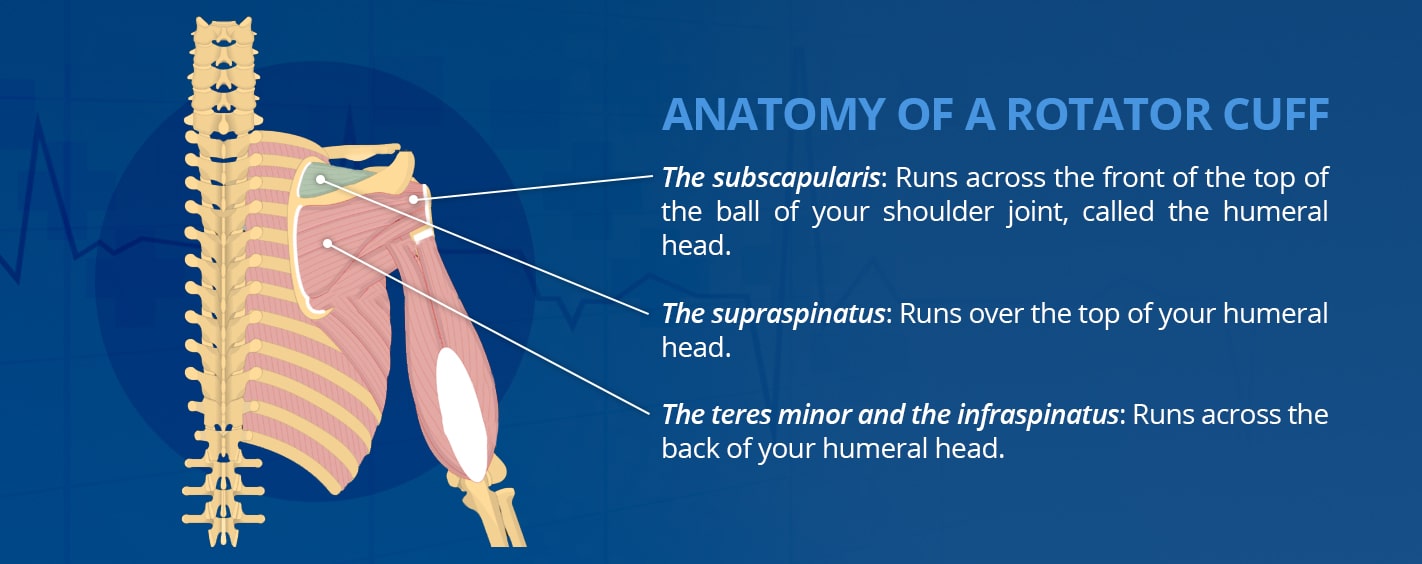
Your rotator cuff is made up of a group of four tendons working together to stabilize and move your shoulder. Each tendon connects a muscle that originates on your shoulder blade to part of your upper arm bone, called the humerus. The names of the rotator cuff muscle-tendon components are:
- The subscapularis: Runs across the front of the top of the ball of your shoulder joint, called the humeral head.
- The supraspinatus: Runs over the top of your humeral head.
- The teres minor and the infraspinatus: Runs across the back of your humeral head.
Symptoms of Rotator Cuff Tears
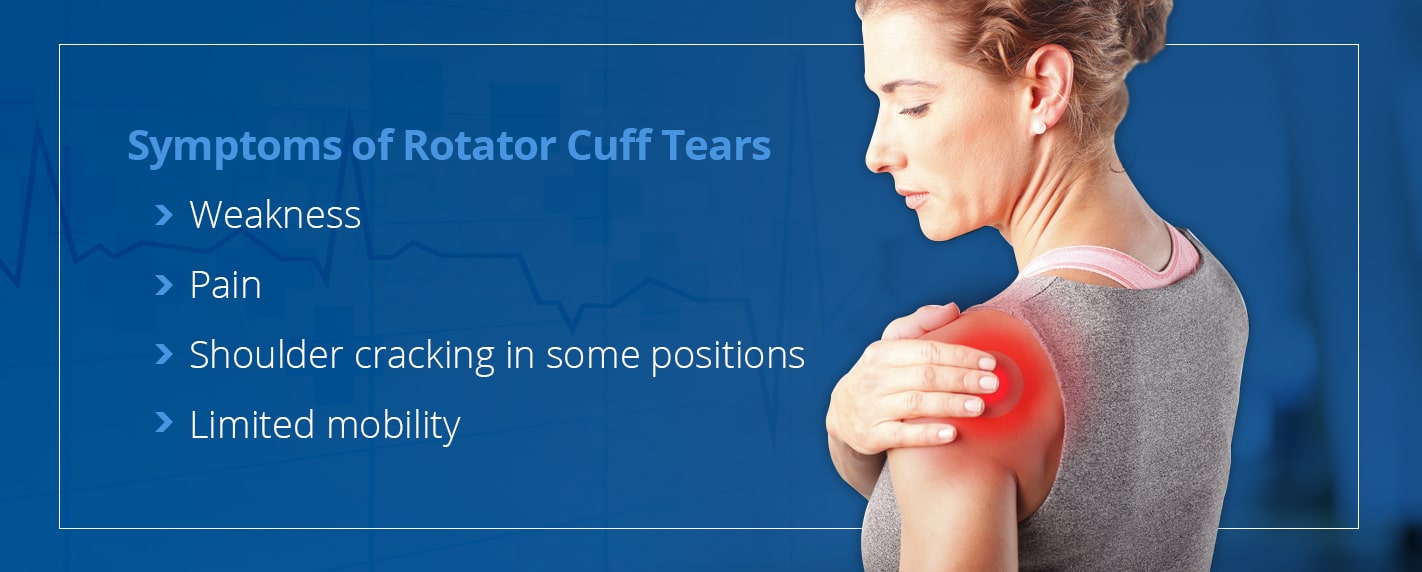
Every type of rotator cuff tear can come with its own set of symptoms. An acute rotator cuff tear can cause extreme, immediate pain, and significant loss of arm strength. An acute rotator cuff tear may cause a “snap” feeling in your shoulder.
Chronic tears normally begin as mild pain, which you might feel only when you execute a particular arm movement. But, as time goes on, the pain can become consistent, widespread and debilitating. Some common symptoms of a rotator cuff tear are:
- Weakness
- Pain
- Shoulder cracking in some positions
- Limited mobility
Many mistake rotator cuff tear symptoms for other medical condition symptoms like subacromial impingement syndrome and suprascapular neuropathy.
Types of Injuries That May Lead to Rotator Cuff Tears
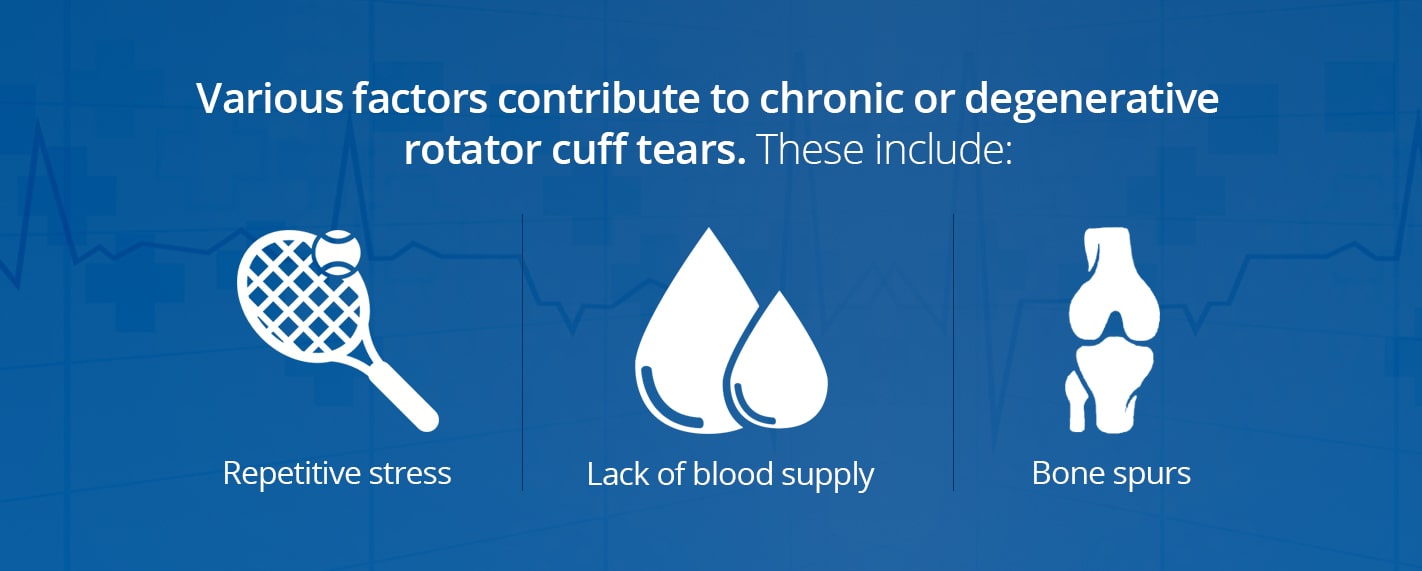
The injuries more apt to cause a cuff tear are injuries where you force your elevated arm downward (an eccentric force), or when you attempt a sudden, jerking lift of your shoulder (a concentric force).
Below are some of the various types of injuries that could cause a rotator cuff tear:
1. Acute Injury
Out of all rotator cuff tears, this is the least common reason. Attempting to lift something heavy with a lurching motion or falling from a great height can cause an acute rotator cuff tear.
2. Chronic Injury
Rotator cuffs often tear because they’ve been worn down. And, this wearing down comes from repetitive stress, which is typically caused by arm motions linked with sports like tennis, weightlifting, swimming, rowing and baseball or with jobs like carpentry and painting.
3. Degenerative Injury
Older individuals are more susceptible to rotator cuff tears. Like with any muscle, your rotator cuff loses its vitality as you age. Various factors contribute to chronic or degenerative rotator cuff tears. These include:
- Repetitive stress: When you repeat the same shoulder movements over and over, it can stress the muscles and tendons of your rotator cuff. Examples of this would be sports activities, like weightlifting and tennis, and certain routine chores and jobs involving overuse and stress.
- Lack of blood supply: As you get older, your supply of blood in your rotator cuff tendons lessens. When you don’t have a decent supply of blood, the natural ability of your body to repair damage to a tendon becomes impaired, which can cause a tendon tear.
- Bone spurs: Also, as you age, bone spurs frequently develop on the acromion bone on the underside. When you lift your arms, these spurs start to rub against the rotator cuff tendon. Known as shoulder impingement, the tendon will weaken over time and make tearing more likely.
4. Tendinitis
Tendinitis is irritation or inflammation of a tendon that connects to a bone. It leads to pain in the site right outside the joint. Swimmer’s and pitcher’s shoulder are common forms of tendinitis.
5. Bursitis
Bursitis is when your bursa, a small fluid-filled sac protecting your rotator cuff, becomes irritated. It may occur when you repeat the same movement, again and again, such as lifting something over your head or throwing a baseball. An infection can also cause bursitis.
6. Tendon Strain or Tear
A full or partial tear can occur in your tendon during a sudden injury or because of repetitive motion. When you don’t have tendonitis treated, it can also cause a tendon tear. A rotator cuff tear causes weakness, pain and inability to freely move your arm in a complete range of motion. It can also be painful during overhead activity for you to lift and turn your arm.
7. Shoulder Impingement
Shoulder impingement is a common reason for shoulder pain and occurs when your rotator cuff catches or rubs on your shoulder bones. It leads to persistent pain as your tendons become injured and start swelling. If not treated, shoulder impingement can cause a rotator cuff tear.
Types of Rotator Cuff Tears
A rotator cuff tear can range from small to large. One or more of your tendons in your rotator cuff could tear if you continue the activity and don’t have the injury treated. Then the tear can become worse. It’s essential you receive the right treatment so your rotator cuff can function optimally.
Below are the different types of rotator cuff tears:
- Partial rotator cuff tears: This is a damaged rotator cuff tendon, but it’s not torn all the way through. This is also called a partial thickness tear.
- Complete rotator cuff tear: This is when you have soft tissue that tears into two different pieces. Often, the tendons tear away from the upper arm bone. A full thickness tear doesn’t heal by itself since your muscles pull the tear’s edges apart. But, it is possible for a partial or full thickness tear to stabilize and leave your shoulder with reasonable function and comfort.
- Acute tear: Trauma or injury causes these tears. For instance, if you lift a heavy object too awkwardly or quickly, you could tear your rotator cuff. Similarly, if you encounter a fall involving an outstretched arm, you could have an acute tear. Shoulder injuries, such as a dislocated shoulder or broken collarbone, can also cause an acute rotator cuff tear.
- Degenerative tear: Many rotator cuff tears occur from a slow wearing down of your tendon and have multiple origins. Genetics and specific health conditions like high cholesterol and diabetes can also cause them too. Because of this, your dominant arm will is more likely to get a rotator cuff tear because you tend to use it more, and it experiences repetitive stress. Degeneration also naturally occurs as you age, increasing your chances of injury over time.
Diagnosis and Repair of Rotator Cuff Tears
If you’re suffering from a rotator cuff tear, and you continue to use it despite the increase in pain, you could damage it further. Rotator cuff tears can become larger over time.
Chronic arm and shoulder pain are good reasons to contact your doctor. You can prevent your symptoms from becoming worse by seeking early treatment. It can also help you get back to your routine more quickly.
The treatment’s goal is reducing pain and restoring function. You have several rotator cuff tear treatment options, and the best choice differs for everyone. When tailoring your treatment plan, your doctor will take your age, general health, activity level and type of tear you have into consideration.
Diagnosing and repairing rotator cuff tears include one or more of the following:
1. Distinguishing Rotator Cuff Tears From Other Conditions
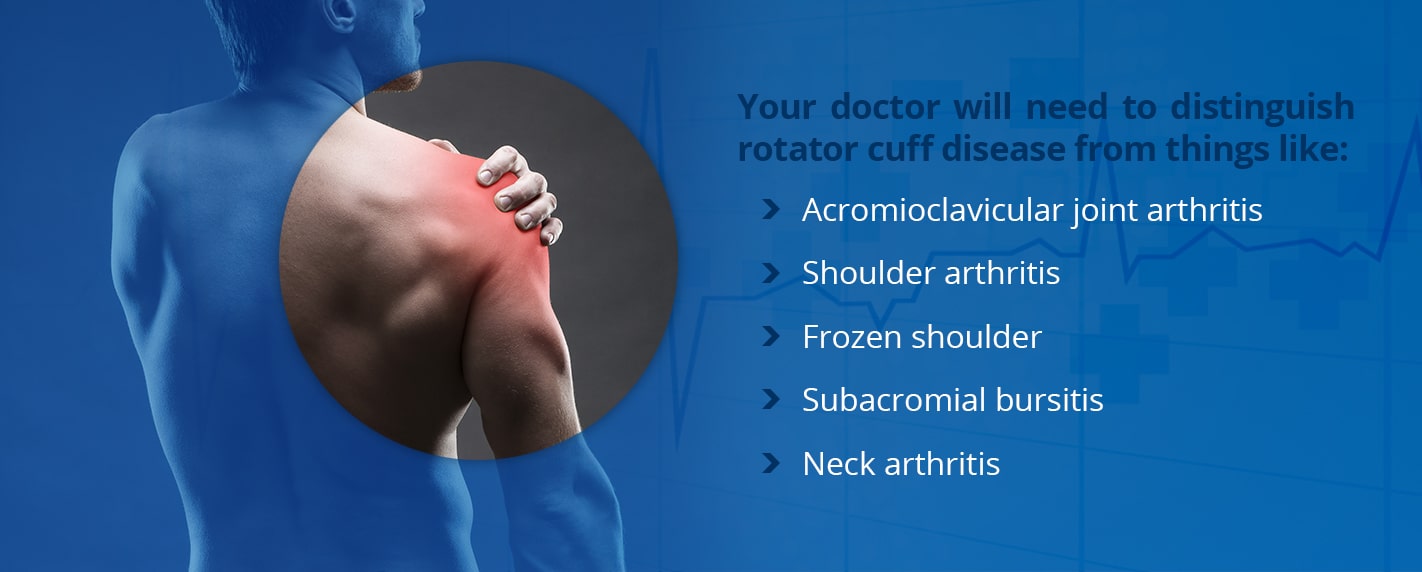
Your doctor will need to distinguish rotator cuff disease from things like:
- Acromioclavicular joint arthritis: This condition produces localized pain to the top front of your shoulder that’s worsened by using your arm in front of your body. You usually have normal shoulder strength.
- Shoulder arthritis: This type of arthritis causes limited shoulder motion and pain.
- Frozen shoulder: This is marked by stiffness in your shoulder, but your shoulder is typically strong.
- Subacromial bursitis: Bursitis causes pain and catching in your shoulder, but you maintain shoulder strength.
- Neck arthritis: When combined with nerve impingement, neck arthritis could cause shoulder weakness and pain that worsens when you hold your head in certain positions. Electromyography could identify nerve issues in your neck.
After talking with your doctor about your medical history and symptoms, they’ll examine your shoulder. They’ll check to see if there’s any deformity or if it’s tender in any spots. They’ll have you move your arm in various directions to measure your shoulder’s range of motion. They’ll also test the strength of your arm.
They’ll also check for other issues with the joint of your shoulder. They’ll likely examine your neck as well to ensure the pain isn’t due to a “pinched nerve,” and to rule out other medical conditions such as arthritis.
2. Getting Imaging Tests
The doctor may use imaging tests to help confirm your diagnosis such as:
- X-rays: These are typically the first imaging tests doctors perform. Since they don’t show your shoulder’s soft tissues, like your rotator cuff, standard x-rays of a shoulder having rotator cuff pain are typically normal or might show a minuscule bone spur.
- Ultrasound or magnetic resonance imaging (MRI): These tests show soft tissues, like rotator cuff tendons, better. They can show tears of the rotator cuff, the location of the tear within the tendon and the tear’s size. The doctor can also use an MRI to give them a better idea of how “new” or “old” your tear is since it can show the rotator cuff muscle’s quality.
3. Participating in Nonsurgical Treatment
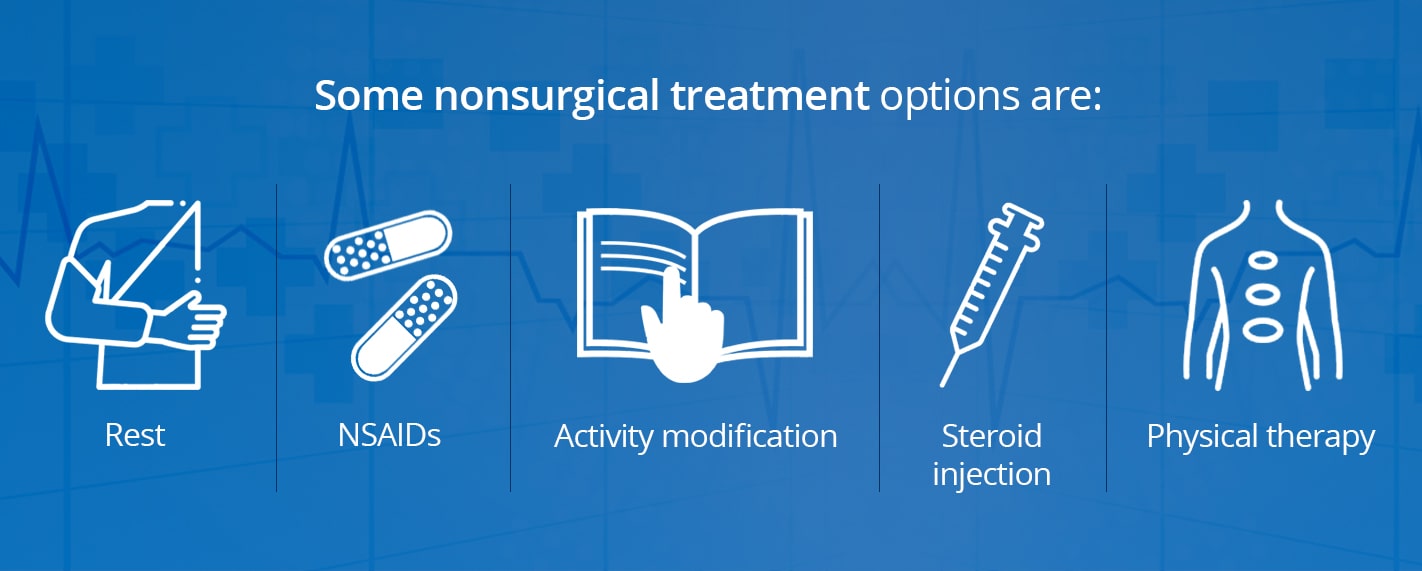
There’s no evidence of a better outcome from the surgeon performing surgery closer to the time of injury versus later down the road. Because of this, a lot of doctors first recommend physical therapy as well as other nonsurgical treatments to manage rotator cuff tears. In many individuals, nonsurgical treatment relieves pain and improves shoulder function.
The main benefit of nonsurgical treatment is to avoid major surgery risks, such as:
- Permanent stiffness
- Infection
- Lengthy recovery time
- Anesthesia complications
Nonsurgical treatments have a couple of disadvantages. You may have to limit activities, and the tear’s size could increase over time
Some nonsurgical treatment options are:
- Rest: The doctor might recommend rest and limiting overhead activities. They might also prescribe you a sling to keep your shoulder still and protect it.
- Nonsteroidal anti-inflammatory drugs (NSAIDs): Medication, like naproxen and ibuprofen, reduce swelling and pain.
- Activity modification: Avoid shoulder pain-causing activities.
- Steroid injection: If standard medications, rest and physical therapy don’t help relieve your pain, a local anesthetic injection and cortisone preparation could help. Cortisone is typically an extremely effective anti-inflammatory medication, but it’s not useful for everyone.
- Physical therapy and strengthening exercises: Specific exercises can help strengthen your shoulder and restore movement. The exercise program will likely include stretches for improving range of motion and flexibility. Strengthening your shoulder-supporting muscles can prevent further injury and relieve pain.
Although doctors typically recommend prompt surgery for acute cuff tears in healthy shoulders, certain exercises could help maintain strength and flexibility of joints with long-standing tears. Usually, you can perform these exercises from your home with little equipment. They’re best performed gently and a few times daily. These exercises are not dangerous if you perform them gently, so there’s no risk of enlarging the rotator cuff tear.
4. Undergoing Surgical Treatment
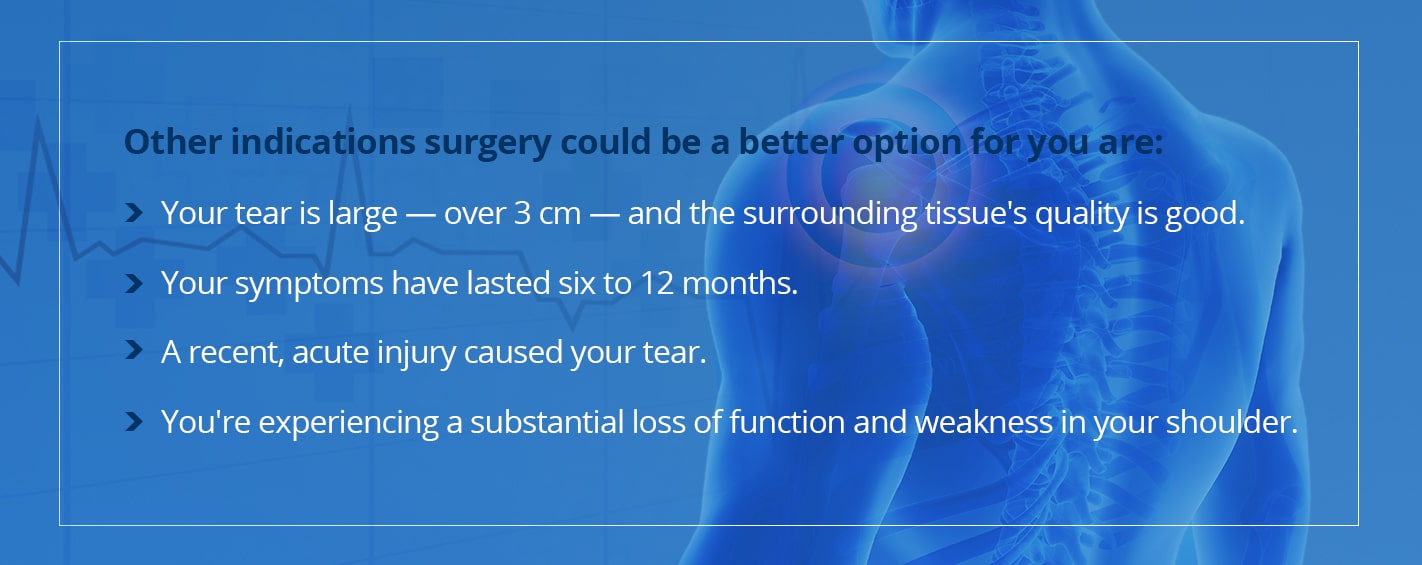
Your doctor could suggest surgery if there’s no improvement in your pain with nonsurgical methods. Persistent pain is the primary indication for surgery. If you’re an active person and use your arms a lot for sports or overhead work, the doctor might also recommend surgery.
Other indications surgery could be a better option for you are:
- Your tear is large — over 3 cm — and the surrounding tissue’s quality is good.
- Your symptoms have lasted six to 12 months.
- A recent, acute injury caused your tear.
- You’re experiencing a substantial loss of function and weakness in your shoulder.
Surgical repair of a torn rotator cuff usually involves the surgeon re-attaching your tendon to the head of your humerus. Several options of rotator cuff tear repair exist. Your surgeon will sit down with you and talk about the best surgical procedure that will be most suitable for your case.
The more force needed for producing a tear, the more chances the tear can be surgically repairable. A healthy tendon requires a lot of force to tear it. Surgeons can often repair a tear resulting from major injury if you don’t delay surgery for more than a few weeks.
Degenerative, weakened cuff tissue is easier to tear even by regular activities. Surgeons might not be able to perform a durable repair of these tears due to the lack of sufficient quality and quantity of tendon tissue. Because of this, individuals need to seek prompt examination by an experienced shoulder surgeon of shoulder weakness, particularly if an injury causes the weakness or it comes on suddenly. An experienced shoulder surgery surgeon can repair rotator cuff tears even if there’s a small amount of quality tendon tissue.
Surgical Options
There are a few variations of rotator cuff surgery the surgeon can use to manage cuff tendon issues. One essential goal of surgery is to enable the smooth passage of your humerus underneath what’s known as your coracoacromial arch. The surgeon generally accomplishes this by removing chronic bursitis, scar tissue, irregular tendon edges and bony prominences.
A “smooth and move” procedure is the combination of smoothing with immediate, post-operative movement. When there’s enough quality tendon tissue, the surgeon can anchor the cuff tendon’s torn edge to your humerus from the point it was torn, thereby helping it heal back to your bone.
Some individuals advocate shoulder arthroscopy for rotator cuff tear repair. However, it’s not clear if this more complex method has benefits over a professionally performed open repair. Others suggest using various artificial or biological grafts or tendon transfers for bridging what would be otherwise irreparable rotator cuff defects.
Rotator Cuff Surgery Benefits
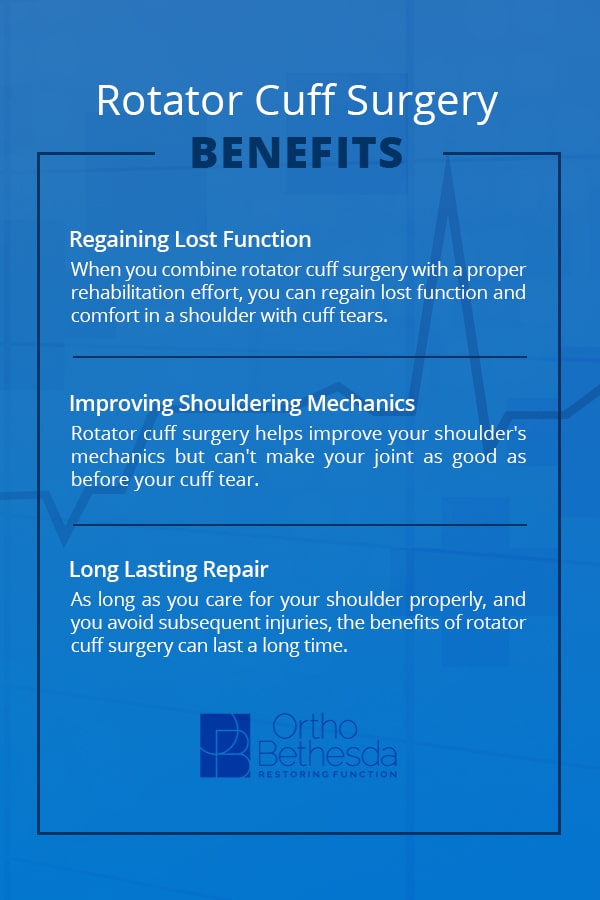
You can achieve several benefits if you undergo surgery for a rotator cuff tear. These include:
1. Regaining Lost Function
When you combine rotator cuff surgery with a proper rehabilitation effort, you can regain lost function and comfort in a shoulder with cuff tears. This procedure, in experienced hands, can address restrictive scar tissue and roughness that often accompany cuff disease. If the quality and quantity of tissue are decent, surgery helps repair the tendon back to your bone. Those who have healthy shoulders, don’t smoke and haven’t had multiple cortisone injections are more likely to have a successful outcome after a cuff tear.
2. Improving Shouldering Mechanics
Rotator cuff surgery helps improve your shoulder’s mechanics but can’t make your joint as good as before your cuff tear. Typically, the muscles and tendons around the shoulder have experienced prolonged disuse and have weakened before the surgery. The tissue might not be sufficient enough for a durable repair. In these cases, carefully smoothing the cuff area, and moving your shoulder right after your surgery helps to prevent new scars forming and potentially impacting your shoulder mechanics.
3. Long Lasting Repair
As long as you care for your shoulder properly, and you avoid subsequent injuries, the benefits of rotator cuff surgery can last a long time. But, it’s essential you understand surgery can’t improve the basic tendon tissue quality. So, recurrent tears often follow poor-quality tissue repair.
If the surgeon repairs the cuff, it could be months before your tendon heals solidly to your bone. You must avoid strengthening exercises during this time so you don’t impair the healing. After the healing, it could take several months of gentle exercise before your shoulder will achieve maximum improvement.
The procedure’s effectiveness depends on your motivation and health, the surgeon’s expertise and the condition of your shoulder. When an experienced surgeon performs rotator cuff surgery, it usually results in improved shoulder function and comfort. The best improvements are when you can perform everyday activities, sleep and engage in non-contact recreational activities.
Contact OrthoBethesda for Rotator Cuff Surgery

Our team of doctors, therapists and staff members are committed to providing you with outstanding patient care. All our Board Certified Orthopaedic Surgeons are experts in treating issues relating to joints, bones, hands, feet, extremities and spine. We treat various disease processes like tendon, arthritis, sports-related concerns and ligament and tendon injuries.
Contact our office to schedule your rotator cuff surgery appointment.
Related Content
- Can a Rotator Cuff Tear Heal Without Surgery?
- Can You Drive After a Rotator Cuff Repair?
- Complete vs. Partial Rotator Cuff Tears
- Rotator Cuff Disorders: The Facts
- The Difference Between Rotator Cuff Tears and Shoulder Tendonitis
- When Not to Have Rotator Cuff Surgery
- Shoulder Pain – Frozen Shoulder
- How to Avoid Shoulder Pain While Playing Golf
- Why Sleeping on Your Side Is Killing Your Shoulder
- Shoulder Pain – Cervical Spine
- The Ultimate Guide for Shoulder Recovery Surgery
- Does a Broken Shoulder Need Surgery?
- How Dr. Craig Miller Uses New Technology to Improve Shoulder Surgery
- Shoulder Arthritis and Shoulder Replacement
- How to Sleep After Shoulder Surgery
